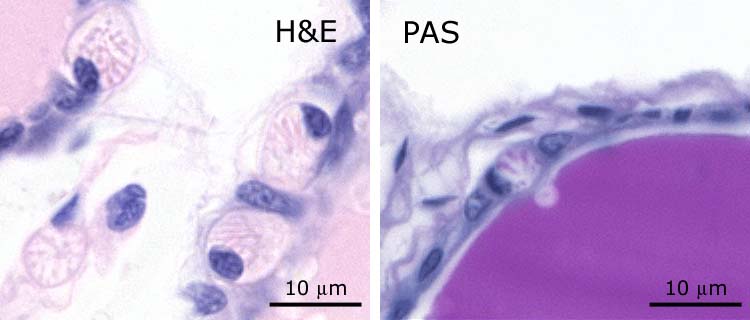The rodlet cell is particular cell type which has been described in association with various organs in teleosts. In H&E staining, it has a bright cytoplasm with, depending on the plane of section, coarsly striated or punctuated eosinophilic (rod-like) structures. The small nucleus has an excentric location. The intracellular rod-like structures of rodlet cells have a positive reaction with periodic acid-Schiff (PAS), which makes them even more easily discernible.
In the RIVM's zebrafish stock, rodlet cells were observed in a number of organs:
- thyroid (interspersed between follicular cells):
gill (probably subepithelial) and gill associated lymphoid tissue:
thymus (also with a subepithelial location):

The rodlet cell has been designated as enigmatic, and there is still debate about its role. The following examples illustrate the diversity of postulated functions for which clues were found (mainly in morphological studies):
References
In the RIVM's zebrafish stock, rodlet cells were observed in a number of organs:
- thyroid (interspersed between follicular cells):

gill (probably subepithelial) and gill associated lymphoid tissue:

thymus (also with a subepithelial location):

| gut (associated with the germinative layer of the epithelium): | liver (associated with small blood vessels): |

The rodlet cell has been designated as enigmatic, and there is still debate about its role. The following examples illustrate the diversity of postulated functions for which clues were found (mainly in morphological studies):
- indications for holocrine secretion were derived from ultrastructural characteristics of the rodlet cells of the bulbus arterious endothelium in carp1;
- also in carp, rodlet cells were found in association with delicate blood vessels in the kidney, but only in seven out of 50 fish. The ultrastructural features in this study were suggestive of some kind of "symbiosis" between leukocytes, possible granulocytes, and the parasitic rodlets. The cells serve the rodlets as an incubation chamber, as well as a means of transportation into the bloodstream after ripening2;
- in minnows, rodlet cells were found in association with the inflammatory reaction on encapsulated nematode larvae in the pancreas. The number of rodlet cells correlated significantly with the parasitic infection in the fish. The data were considered to be suggestive for rodlet cells as an inflammatory cell type closely linked to other piscine inflammatory cells, such as eosinophile granulocytes, epithelioid cells and mesothelial cells3.
References
- Grunberg W, Hager G. [Ultrastructural and histochemical aspects of the rodlet cells from the bulbus arteriosus of Cyprinus carpio L. (Pisces: Cyprinidae)]. Anat.Anz. 143:277-290;1978
- Fishelson L, Becker K. Rodlet cells in the head and trunk kidney of the domestic carp (Cyprinus carpio): enigmatic gland cells or coccidian parasites? Naturwissenschaften 86:400-403;1999.
- Dezfuli BS, Simoni E, Rossi R, Manera M. Rodlet cells and other inflammatory cells of Phoxinus phoxinus infected with Raphidascaris acus (Nematoda). Dis.Aquat.Organ 43:61-69;2000.